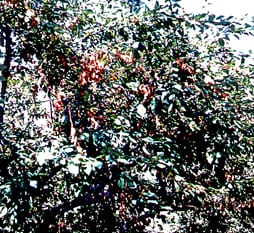AKA MADRONE DECLINE
Thielaviopsis basicola (fungus)
Elm and madrone are most affected and is found throughout the United States: including Central California.
Heavy, cold, slightly acid to alkaline soils, well supplied with humus. Soils with pH lower than 5.6 and sandy soils low in organic matter are less conducive to disease development.
Symptoms include root rot leading to yellowing of foliage and dieback of branches; eventually fatal. Basal stem discoloration extends some 6 inches above the soil line.
The fungus lives in the soil saprophytically, typically entering the roots through wounds caused by nematodes. Two types of spores are formed: (1) colorless, cylindrical conidia (phialospores) are arranged in line with a colorless hyphal tip, breaking off one by one into the soil. (2) Dark, thick-walled aleuriospores exposed in chains, eventually breaking apart. These function as resting spores (chlamydospores) capable of resisting unfavorable soil conditions and providing longevity as dormant spores. The spores are picked up by feeding nematodes to be deposited within the host. Or, they may be carried on nematode bodies, eventually entering the roots via germination tubes growing through feeding wounds made by the nematodes.


